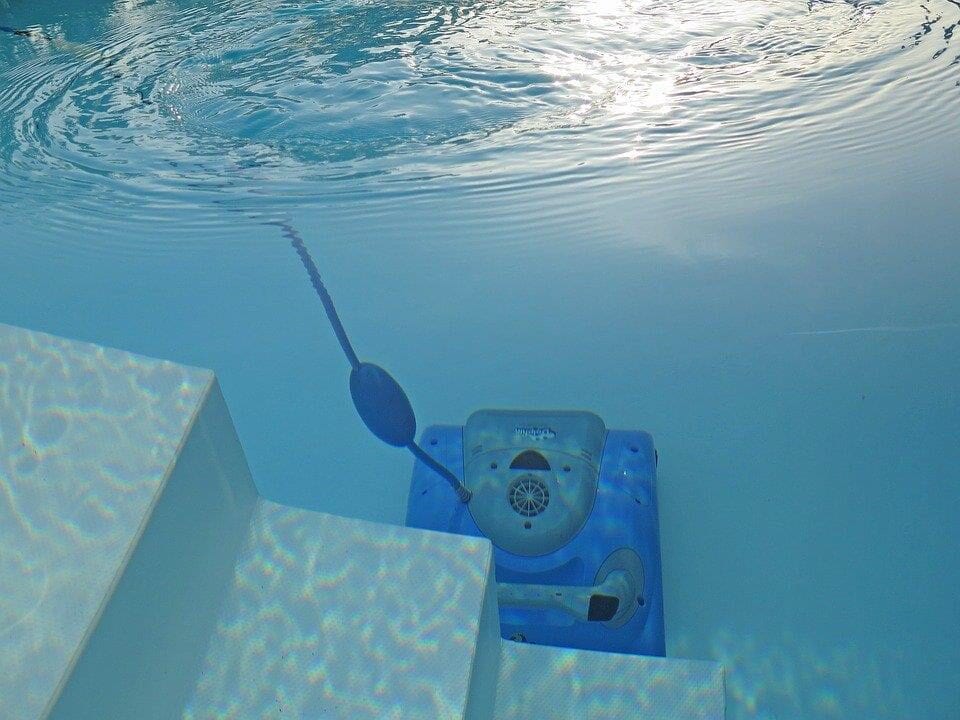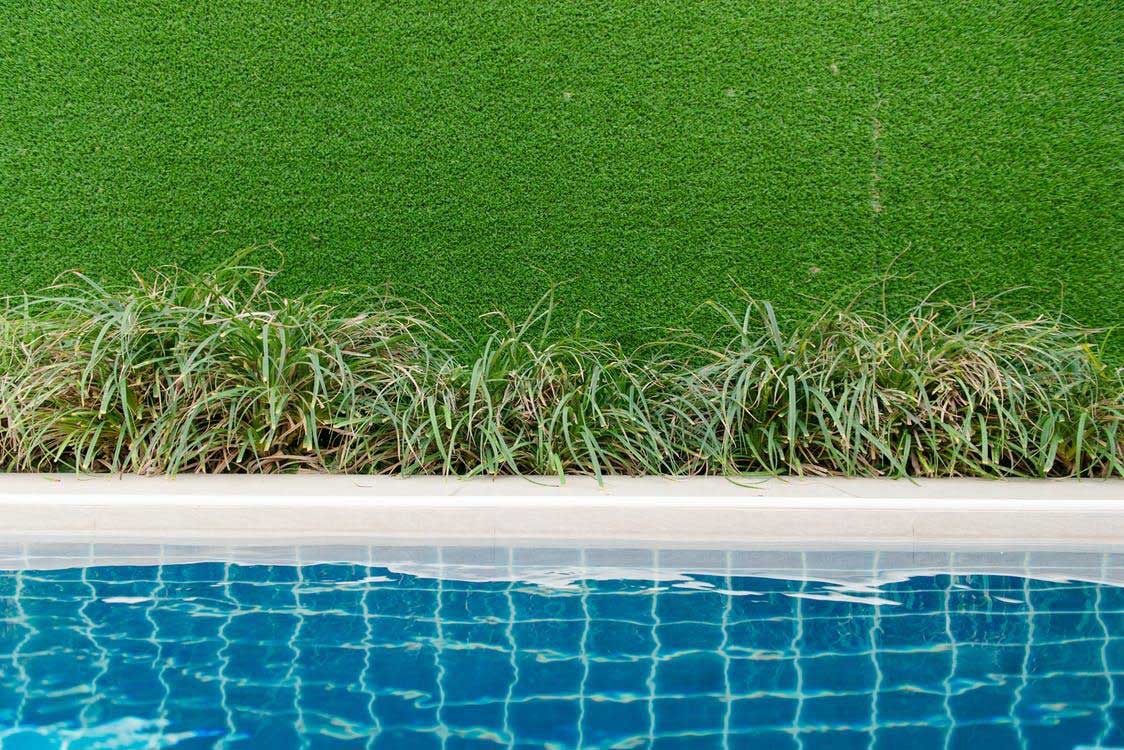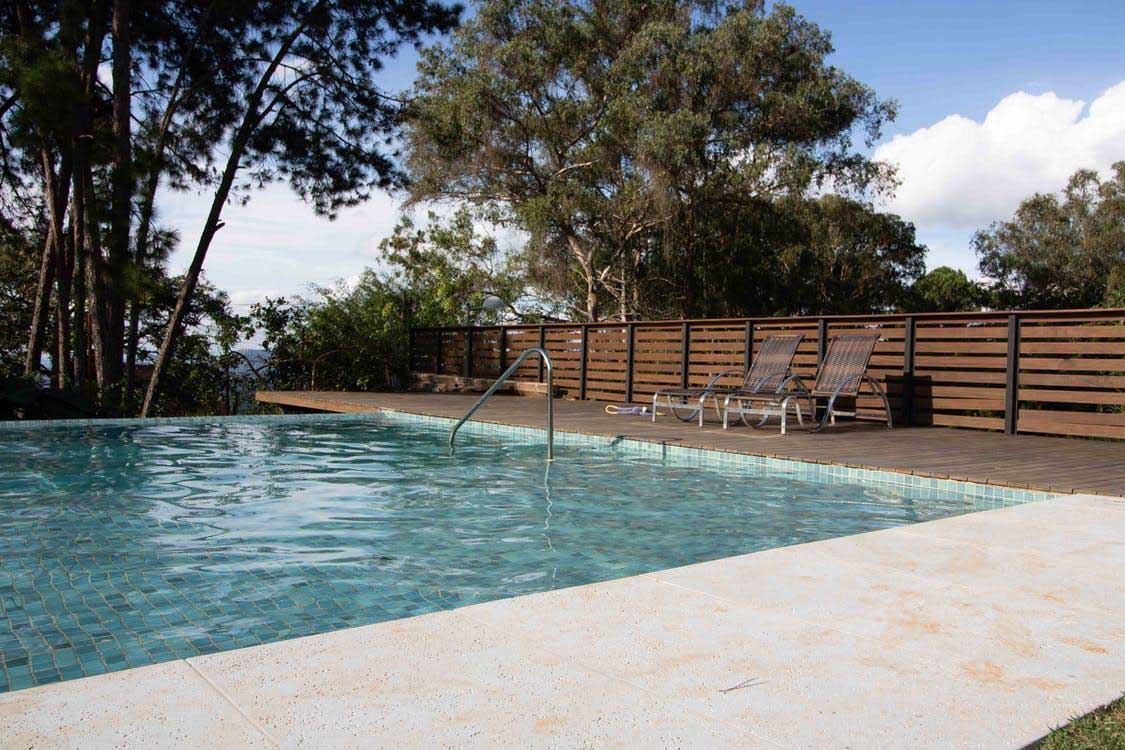BLOG
Essential Blog Articles on Pool Services
POOL REPAIRS-WHY YOU NEED A POOL CONTRACTOR
I hope this blog helps you I also have videos on my YOUTUBE CHANNEL going over the same topics if you wish to watch it in a video blog. Please see below! If you would like us to check out your Pool the CONTACT US and we’ll be happy to help.

TOP 6 REASONS TO HIRE A POOL SERVICE COMPANY
Here are some great reasons to hire a Pool Service Company.
Check out this BLOG full of Great information.
TOP 6 REASONS TO HIRE A POOL SERVICE COMPANY
A question I’m asked a lot is “why should I hire a pool company?”. There are countless reasons for doing so, ranging from “I want to make sure my surface lasts as long as possible”, to “I’m just too lazy or don’t have the time to do it each week”. It doesn’t matter what your reasons are. If you’re ready to hire a Pool Service Company, then it’s time. Here are the top 5 reasons for hiring a Pool Service Company.
- Preventative and consistent pool service. You need to stay on top of your pool regularly to keep your pool safe and healthy. If you don’t, you may start growing algae, your pool chemistry will get out of balance quickly which can cause premature surface wear; your equipment can prematurely wear out and so on and so forth. This is something a pool company should be taking care of for you. Preventative a d consistent pool service that only a pool service can provide. What is meant by a pool service company is a QUALITY pool company. For every company that is quality, there are a multitude of companies that aren’t. Verify your pool service company before allowing them to touch your expensive pool.
- CLEANING A POOL IS TIME CONSUMING. We can spend anywhere from 20-45 minutes to clean your pool. We are ultra-efficient with our cleaning and service methods since we do this day in and day out. If you don’t, you can spend anywhere from 1-2 hours per week cleaning and balancing your pool. A lot of people rather spend that time elsewhere and would rather hire a pool service compound to save that time each week.
- POOL STORE CHEMICALS ARE EXPENSIVE. The majority of pool stores offer free water testing. They do that to lure you in. They run their tests and give you a printout of the all the chemicals you supposedly “need” in order to chemically balance your pool. Often ties these chemicals are very expensive and by the time you factor in all the costs and time with going to the pool store each week, a pool service is cheaper.
- IT CAN TAKE LONGER TO CORRECT ISSUES WITH YOUR POOL. A homeowner may not know how to resolve an issue(s) with their pool, whereas a pool service pro would be able to figure the issue(s) out immediately. Perhaps their isn’t enough stabilizer in the pool ;with the sun burning away the chlorine there is now algae in the pool.
- AVOIDING CATASTROPHIC FAILURES. A Licensed qualified quality pool company should help you avoid any catastrophic failure that will Result In. having to purchase major equipment to keep the pool running. For example, putting chlorine tablets in the skimmer could result in the destruction of your pump seals, heaters and so on. A quality pool company would not do this.
- YOU GET WHAT YOU PAY FOR! Are the “savings” you get from hiring a cheaper company really worth all of the headache and frustration? Someone who is only charging $60-$70 for service per month literally has to spend as little time as possible at your home in order to make anything so they can do as many Pools as possible. What you’ll get for that price is a lack of quality in service and your Pool having ongoing problems.
WHY POOL INSPECTIONS ARE SO IMPORTANT!
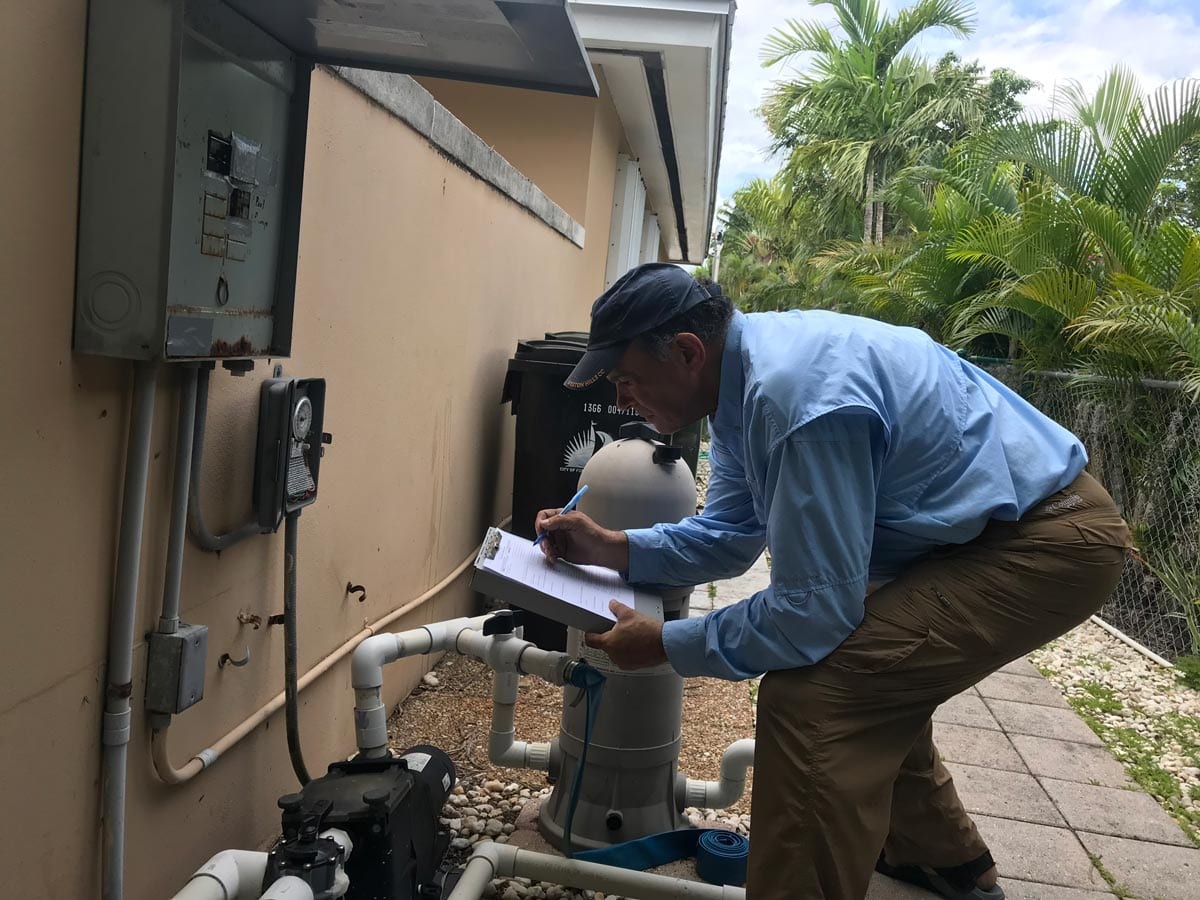
Everyone incorrectly assumes that Pool Inspections are unnecessary because my home inspector inspects the Pool. Home inspectors are NOT Pool Experts; they don’t know the intimate details of a Swimming pool and its functions. Home inspectors put the timer switch on and if it turns on, the Pool gets a green check mark.
There is so much more to it than that. There’s surface cracks, Pool leaks, lights not working, cracked decking, coder issues, botched equipment and the list goes on and on. Pool Inspections should have just as much detail paid to it as you’re home does. Some Pools can be as expensive as a small house. Do you want to take a chance and hope your Pool is going to work properly and inherit a problem(s).
It would be much better to have your Pool Inspected by a Professional Pool Inspection Company. You’ll want to make sure they are Nationally Certified with the NATIONAL SWIMMING POOL FOUNDATION (NSPF) prior capital words In teal linked to NSPF.org website) and being a State Licensed Pool & Spa Contractor is also a great credential. GLOBAL POOLS is CERTIFIED IN POOL & SPA INSPECTIONS BY THE NSPF. Being a Contractor means they should pay attention to code issues during the Pool Inspections which adds incredible value to your inspection.
If you need your Pool Inspected, please don’t hesitate to CONTACT US .We’ll be happy to endure that your purchase is a safe bet. Our reports are detailed with pictures of the Pool being inspected. We are also CERTIFIED IN POOL LEAK DETECTION and can determine if your Pool is Leaking. Perform a PRE-PURCHASE Pool Inspection and Leak Detection to find out the condition of your Pool and if your Pool is Leaking.
WHY MAINTAIN YOUR POOL?
One of the greatest luxuries is having a Pool in your very own backyard. The costs of maintaining your Pool will rise if not done with frequency. Brushing the tie, cleaning the filter and many other technical aspects of maintaining a Swimming Pool can be confusing and tedious if your are not sure what to do. Hiring a Licensed and Insured Pool Company to manage your Pool will be one of the best decisions you will make as a Pool owner!
The environment can very easily contaminate your Pool water due to something as simple as mowing your yard kicking in excess debris into the water or a large rainstorm can make your Pool water unbalanced. Sometimes it’s not so easy to tell because it’s not always visible. When left untreated, serious health problems could occur.
A Pool Service Company such as GLOBAL POOLS, (prior words in teal with link to “our pool services” page can make your life as a Pool owner very easy. The specialist removes any debris in the Pool and also adjusts the water appropriately to achieve balanced water. If a person does not understand the process for balancing the water and is not knowledgeable, It could turn a safe pool into an unsafe pool into an unsafe Pool. Consequently, we will keep your Pool healthy all year!
As we all know, water can be crystal clear and blue one day and green and murky the next day. The reason for this is built up bacteria ad algae that has been left behind due to faulty cleaning methods and as a result are allowed to culture in your Pool. If you do not know how to clean a Pool filter we will be happy to help! When your Pool Company services your Pool each week, the chances of this happening is almost completely eliminated. Places like the walls, steps and the basket, when taken care of properly, hinder the possibility for these types of buildups.
Allowing a Pool Specialist to take care of your Pool takes the stress and burden off of you. The better maintained it is the longer your equipment lasts, you’re less likely to catch an illness, and the list goes on. You can never be too sure what is happening with your Pool, so let a specialist look at it for your!
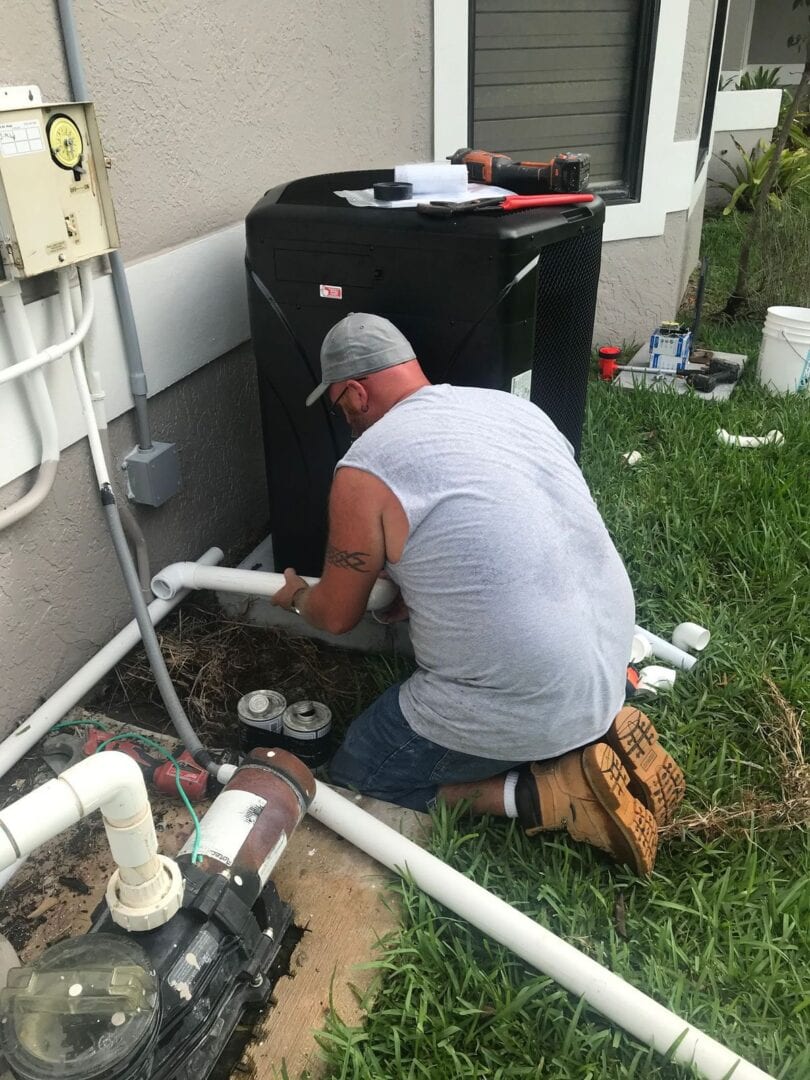
POOL REPAIRS- WHY YOU NEED A POOL CONTRACTOR
Pool repairs are skills most consumers think any “pool guy” or “gal” can do. In Florida, that is not the case. In Florida, anything that requires a tool, requires a license. Technically speaking, you need a license to replace a pressure gauge on a filter. Pool repairs is something that you should seriously consider hiring a licensed Swimming Pool Contractor. There are many benefits in doing so. Feel free to Contact us (try color previous words with link to contact page) .You can verify OUR FLORIDA POOL CONTRACTOR LICENSES here!
CONTRACTORS HAVE A GOOD UNDERSTANDING OF EQUIPMENT
Pool Contractors have demonstrated that they have an understanding of how equipment and structural pool repairs work in order to acquire their license. The unlicensed people have demonstrated over and over again that they do things incorrectly since they lack the proper training and peer review. I have personally seen things installed against manufacturer specifications and installed outright dangerously.
CONTRACTORS WILL OPTIMIZE YOUR REPAIR DOLLARS SPENT
When someone is doing Pool Repairs, it is important to make sure that yo0ur dollars are going towards something that’s will last Fort a long time. If someone is routinely installing equipment incorrectly, it will fail prematurely. And void any manufacturers warranty. Instead of getting 3-5 years out a pump, I’ve seen them fail in as little as one year. In a recent situation, an Unlicensed person connected a pump to a 40a breaker with a 12AWG wire. The wire was overloaded, burnt, and killed the pump. A licensed Pool Contractor would not have done this. The end result was the homeowner paying me to fix it correctly so the pump I installed will last much, much longer!!
CONTRACTORS ARE INSURED AND BONDED
If a licensed Pool Contractor makes a mistake making repairs to your Pool, they are insured. Providing general liability coverage is one of the requirements of being a Pool Contractor, and protects the homeowner.
CONTRACTOR’S CAN PROVIDE A WARRANTY
Manufacturers are behind licensed Pool Contractors who are installing their equipment for Pool repairs. They are doing this by giving Licensed Pool Contractor’s a longer Warranty than those installing equipment who are unlicensed. Some of the manufacturers give ZERO warranty for unlicensed or homeowner installs. Others will provide up to 60 days for unlicensed or homeowner installs. However, for those who are licensed, they can give up to 4 years of warranty on a single piece of equipment (depending on what it is and who makes it). So as the homeowner, you need to ask yourself if saving $100.00 from an unlicensed company is worth the savings when the warranty is so much stronger and having piece of mind knowing a Licensed Pool Contractor is installing your equipment .For example, “Jandy’s Limited Warranty will NOT cover Jandy equipment that is NOT purchased from and installed and/or serviced by a Professional”.
POOL PREPARATIONS FOR A HURRICANE OR STORM

Every time a Hurricane comes around, I receive questions about what should be done about the Pool?
Please read below the list of things that can help get your Pool and it’s equipment through the storm!
Please read below!
BEFORE THE STORM
- DRAIN YOUR POOL down to the middle of skimmer. In most cases this can be achieved by extending your blue hose to your property line and opening the red valve located at the bottom of your Pool filter or putting your DE/Sand filter into “waste” mode. Keeping water in the Pool provides weight to hold the pool in the ground. An empty Pool is subject to popping out of the ground due to the pressure from the ground water. For further assistance, send an e-mail with a picture of your Pool equipment to Mitchell@globalpools.com.
- TURN OFF POWER to your Pool equipment before the storm hits. Variable speed pumps, controllers, salt systems, etc…. can be very sensitive to voltage spikes a d power fluctuations.You can turn off all the Breakers in the outdoor Pool Electrical panel or turn off the Circuit breaker that controls the Pool Equipment which would be located in the Garage of your home or an outdoor Panel generally located where the power enters the home by your meter.
- DO NOTHING DURING THE STORM. Do not attempt to drain water from your Pool. Do not go for a swim. Do not remove debris from your pool, etc. during a storm. Please wait until after the storm has passed to make any water adjustments. We will need to rebalance every Pool after the storm to get then back on track. To help us with time and to save yourself some money , remove if safely possible any large debris from your swimming Pool after the storm passes. If possible before the storm, add extra chlorine to the Pool to prevent contamination.
- DO NOT PUT ANYTHING IN THE POOL THAT DOESN’T BELONG IN THE POOL!! DO NOT PUT lawn or patio furniture in your swimming Pool. You could cause damage to your swimming Pool surface such as surface chipping and staining.
- CHEMICALS & LACK OF CHEMICALS. Every Pool will need to be chemically evaluated after the storm and rebalanced. It is generally safe to swim in the Pool with little or no chlorine, however be mindful that Algae can grow quickly with warm weather, lack of sanitation, and no circulation. Always rinse off before entering the swimming Pool so no extra contamination is added to the swimming Pool encouraging Algae growth.
- Salt Pool Owners: We know that the low salt lights will be on for a week or two after the storm. There is no possible way to add enough salt the first time on the first visit to get the Pool 100% balanced. We ordered extra Salt and other essential chemicals to be prepared fort the storm, but understand that it will take time as every Pool will need almost every additional chemical in addition to salt. Be patient; if you are an existing client, you will get first priority.
- STORM CLEANUPS: Depending on the severity of the storm, could leave some Pools trashed with excessive debris that will take much longer than usual to make clean. Every Pool will be assessed after the storm and may have a storm clean up fee (fee varies based on the condition of the Pool) to get straightened back out to normal maintenance conditions. Any Pool that needs this will be discussed prior to cleaning to make sure the charge is approved.
WHY YOU NEED A POOL PRO TO CHECK YOUR SWIMMING POOL EQUIPMENT
One of the moist common things I see on estimates is Swimming Pool Equipment either undersized or not working correctly. Both result in a Pool that is working less than optimal. A Pool Pro that understands circulation (not a Pool guy you found on Craigslist) will truly help you understand how things are working and how they can be improved upon. In Florida, a true Pool Pro is someone who is going to be a Licensed Pool Contractor with The State of Florida and have the insurance to complete the work. Global Pools holds both of these necessary requirements to do the work you need.
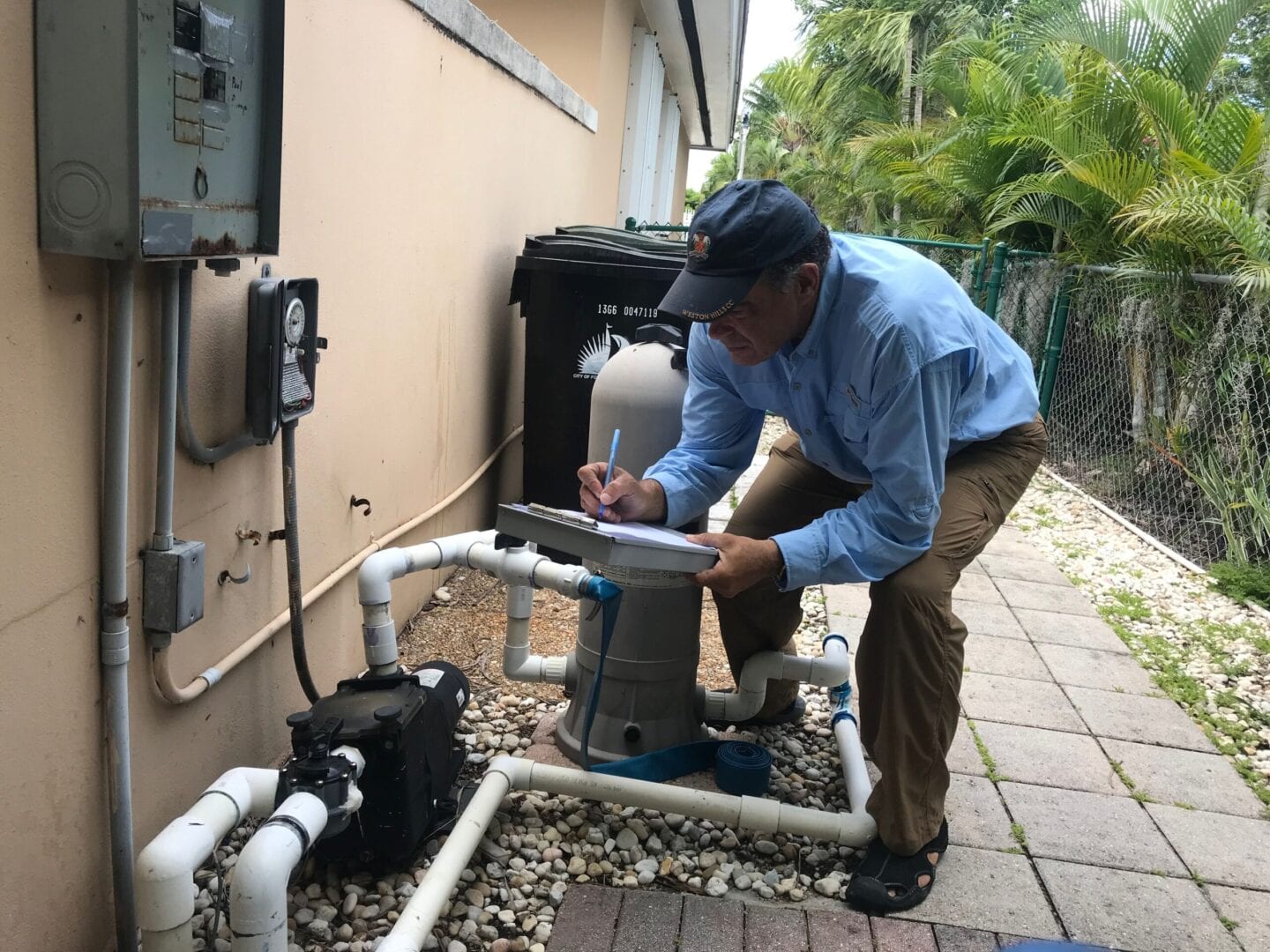
Having undersized equipment or improperly functioning Pool Equipment will always cause you to have the same problems with your equipment. It’s not a question of if, but when are you going to have problems with your equipment. Below are things that can occur when you have equipment issues.
PREMATURE WEAR ON YOUR EQUIPMENT.
Having an overpowered pump or undersized filter will cause premature wear. Your pump is constantly to encounter resistance trying to push way to much water than what your filter can handle, and that will cause premature wear on the pump motor. The filter cannot handle all of the pressure the pump is pushing and the result is premature failure of the cartridge. Both result in clarity issues for your Pool.
QUALITY OF CIRCULATION IS LOST.
If your skimmer is clogged, a glue joint failing or bad-o-ring can cause loss of water circulation quality. When this happens, the circulation becomes erratic and result is water not being cleaned like it should be each day. At some point its going to cause clarity issues and algae growth. I’ve seen this over and over again. When you correct a problem, your Pool will Thank You!!.
OVERSIZED POOL PUMP.
This can cause havoc on everything else on your equipment pad. It could damage your filtering element, and your heater it it’s pushing way way too much water than than the heater is designed to handle. Water erodes metal; how do you think the heater is going to fare?. That’s why its so important to make sure the person installing your equipment is qualified to do so!. The list can go on and on. I’d recommend a Pool Professional take a look at your equipment.
HOW TO CLEAN YOUR POOL THE SIMPLE WAY
- TEST THE WATER- You want to take a water sample 18 inches deep from the surface in order to get the most accurate reading of your water chemistry. You want to take the water sample in the deep end away from any returns or water features.
- SKIM THE SURFACE- You want to quickly remove the surface Debris from the water before it sinks to the bottom. Go around the Pool twice. The first go around will stir the debris stuck to the walls, and by the second go around most of it will be in the middle.
- EMPTY SKIMMER BASKET(S)- Let’s get this out of the way so we can get the surface circulating again(where 90% of the contaminants are); our next step is vacuuming. If there is excessive debris in the skimmer, don’t pull the basket out until the maximum debris you have is contained in the basket. If it is overflowing, pull the debris out by hand wearing gloves until the amount of debris is not overflowing anymore. Pull out the basket when the pump is on so debris get pulled into the basket as you pull up.
- VACUUM-Now is a good time to remove the debris off the bottom of the Pool. Vacuum at a slow and steady pace or you will stir up the debris making cleaning the Pool more difficult and cost you time. Depending on the Pool configuration, I like to vacuum one-half of the Pool at a time.
- ADD CHEMICALS-Now that the Pool is clean, its time time to sanitize the water. You want to add chemicals in the deep end, and depending on what your applying decides how you apply it. It’s a good idea to do this before brushing because certain chemical’s are heavier than water (chlorine and acid) and because of that it will go straight to the bottom. A light brushing will mix up the chemicals. So why brush Twice? TIP: When adding chemicals, try to pour to the water as close as possible to avoid splashing chemicals on your deck and in your eyes.
- BRUSH-Go around the Pool brushing the walls, steps and mix up any chemicals you put in the Pool. Brushing at an angle saves you energy for the rest of your day.
- TILE CLEANING- Clean the tile at least once a week using a quality tile brush and tile soap.
- SKIM THE SURFACE-Do this one last time with a fine mesh net to finish the Pool.This time should require only one trip around the Pool.
- CLEAN THE PUMP BASKET-Any large debris you sucked up while vacuuming will be in the pump basket. If you don’t empty it and continue to let debris build up it’ll prevent consistent circulation that could result in a green Pool or damage equipment. Before you put the lid on the pump basket, fill the basket with water to help the pump prime.
- YOU’RE FINISHED! You should have a sparkling clear Pool. Enjoy your Pool!
SHOULD YOU RUN YOUR PUMP DURING THE DAY OR NIGHT?
One way to save money and run your pump whoever you want is by installing a variable speed pump.
Here are a few reasons why I prefer to run the pump during the day regardless of the savings:
- It’s always best to run the Pool pump during the hottest times of the day. The sun is one of the causes of chlorine depletion in your pool. The water moving around helps protect the chlorine from being burnt our from the sun. If your run your pump during the night, the sun has all day to attack to attack the chlorine that’s standing still in your pool. That can cause algae fast!.
- It’s a great idea to have the pump running when people are using the Pool. Things like sunblock, dirt, sweat, urine, and whatever else people bring into the Pool can wreak havoc on the water quality in your Pool. The majority of people are using their Pool during the daytime, so run your Pool Pump during the day and keep your Pool as clear as possible.
HOW TO CLEAN UP A GREEN POOL.
DAY 1
- Check to see if the Pool needs to be Acid washed. Ask the client how long it’s been green. Can you notice deep stains and thick algae stuck to the walls?. If so an acid wash may be the best way.
- If you are not going to acid wash it, check the stabilizer level. It should be in the range of 30-50ppm. If its in between 50-100, you should be okay and can slowly bring it down by adding fill water, rains, etc. If its over 100, I‘d consider doing a partial drain and refill it get the chemical in range. It’s its too high it’s going to be a battle to keep the pool clear after the clean up process is done.
- IF CYA (stabilizer) is in check then test for PH. It will more than likely be high. Then we can figure out an estimate of how much acid to add. We we want the PH between 7.0-72.
- Try and get as much debris off the floor as you can.This will help the Pool clear up quicker.
- Add the acid, and brush every square inch inch of the Pool including the floor. We want the algae to be stirred up so we can kill it.
- If you have a cartridge filter, remove the element for the first 24 hours. If you have a sand or DE filter , then put the filter on recirculate.
- Turn on the filter only after step 7, and keep the system running 24/7. Introduce the chlorine and Calcium Hypochlorites (super shock-wave brand). You need to do a calculation based off your sized Pool and what you want the chlorine level to be. This is a good program to calculate how much chlorine you need.(link to troublefreepool.com/CFC.html). Calculate how chlorine you need with troublefreepool.com/CFC.html
DAY 2
- Retest the chemicals. Keep the chlorine at shock level ad the PH between 7.0-7.2.
- Add acid if above 7.2.
- Brush the entire Pool and stir everything up.
- If the Pool water has turned blue with a white tint, go ahead and put the cartridge back in or put the sand/DE filter in filter mode. Keep the filter running 24/7.
- Add more chlorine if necessary.
DAY 3
- Clean the cartridge or backwash the filter.
- Repeat steps 1-5 from Day 2.
DAY 4 (If it takes that Long)
- Repeat day 3 until Pool is clear.
- Once the Pool is Clear, rebalance the water to make sure its safe to swim in.
TIPS:
- Always keep the PH between 7.0-7.2 throughout the process.
- If you have a sand filter, you can add a cup or two of DE to help the sand filter work better.
- If you are able to, clean the filter out 2x per day (every 12 hours) to keep the process moving along as quickly as possible.
- Keep the system running 24/7 in order to clear the Pool as quickly as possible.
- If your using Calcium Hypochlorite as your main source of chlorine you will need about 4 ounces of acid per pound of cal-hypo to offset the PH increase the cal-hypo provides.
POOL CARE TERMINOLOGY
When you call a Pool Service Company to come out to service your Pool, they arrive to discuss the condition of your Pool and they throw out all these big terms out in hopes to impress you, but all it does is leave you clueless. We can help with that. Here are some of the common terms that can get you to understand what they are talking about!
ALKALINITY - This should be tested weekly. Total alkalinity measures the total amount of dissolved particles whose PH is higher than 7.0. it should be kept at 80-120 PPM, otherwise it can damage your Pool surface.
BROMINE - It is a sanitizer like Chlorine but generally used in hot tubs or spas. It is more expensive than chlorine.
CHLORINE - It is the most common chemical used for swimming poison sanitizing. It is available in liquid, tablet or granular form.
CYANURIC ACID - CYA is also known as stabilizer and conditioner. CYA is chlorine’s sunblock with appropriate ranges from 30-50-PPM. If it is above or below that it will either renders the chlorine less or completely useless. The only way to remove excess CYA is a partial drain and fill.
DECK CARE - Decks should be taken care of in addition to your Pool water. Your Pool deck can be a breeding ground for mold and bacteria. Have you ever seen those dark concentrated spots on your deck? Clean hose and keep your Pool ad home looking great!
FILTERS - Filters are the lifeline of your Pool filtration system. They are responsible For cleaning the Pool water as it circulates through the filtration system. There are 3 types of filters; Cartridge, D.E. And sand. All 3 require different maintenance schedules and also have different filtering capabilities. They also come in different sizes to accommodate your Pool and filtration system capabilities.
GREEN ALGAE - Green algae is a common result of bad filtration and/or bad water chemistry. If you have a Pool with green algae it does not get better on its own. It will continue to get worse and worse. Chlorine is the chemical that kills it along with shock if necessary using your vacuuming and filtration system to evacuate it from your Pool.
HARDNESS-This is simply the measure of the hardness of your water. If it’s low, it will damage your Pool
Because of how corrosive the water becomes. If it’s too high then it will create scaling at your water line. A hard plaque type substance on your pool walls is scale. That could work into the plumbing and inhibit the water from flowing correctly. The only way to remove hardness is by diluting it with a partial drain and refill.
TEST KIT - A test kit is used to check the status of your water chemistry. It measures all the major chemicals such as chlorine, ph, alkalinity, calcium hardness, cyanuric acid, etc. We prefer the TAYLOR K20056 test kit. Testing should be done at least once a week.
MAIN DRAIN - The main drain aids in cleaning the bottom of the Pool when it gets dirty. It is one of the two main intakes for the pump to push the water into the filter. Be careful if you’re swimming down by the main drain. People have been caught by the strong suction and drowned due to it.
PUMP - Think of the pump as your heart. It is responsible for circulating the water in your Pool and filtration system. If the pump is not working properly it could create problems for your Pool water’s quality and condition. It is imperative to install a pump that is the correct size for your Pool
SALT WATER POOLS - This is one of the biggest myths in the Pool industry. If you have a saltwater Pool you still have a chlorine Pool. The salt cell is responsible through electrodes in altering the chemistry of the salt and turning it into chlorine. The maintenance of yo0ur water is the same with a few ranges being a little different. Periodic special cleaning of the salt cell ensures the production of chlorine for your Pool.
TILE CLEANING-Cleaning the tile prevents a dirty water line and prevents damage to the tile. You can uses a tile cleaning brush or the same brush you use to brush your walls.
VACUUM HEADS - You should vacuum your Pool on a regular bases if your are not using an automatic cleaner. There are 2 different types, depending on your Pool surface; one weighted with wheels for concrete Pools and one with brushes instead of wheels for vinyl Pools.
WEIR - This is the door that sits in the skimmer bay that maintains a steady flow of water into the skimmer. This aids in keeping your filtration system working correctly so air doesn’t get into the system.
AIR BUBBLES COMING OUT OF YOUR RETURN JETS?
Air bubbles coming through the returns of your Pool means somewhere there is air getting into your system. A leak in the suction side of your pump or a broken suction pipe below ground can cause air bubbles.
Look in these places to determine the source of the air bubbles:
- Pump and skimmer baskets. If they are full of debris the pump will suck in air which will make you air bubbles.
- Are your pump and filter o-rings lubed? Area they worn out? This could be the cause of air getting in the system. Try a silicone lubricant, like Magic Lube that may create the seal you need. If not, I would recommend replacing them if they are worn out.
- Look for water collecting at the suction side of the pump, where the PVC goes into the pump. If your pump routinely sucks in air it will melt this joint due to the hear a d can suck air right in with the water which creates air bubbles. If left alone, you’ll soon see the return side of the pump have the same issue. What you can try is apply some A-B putty (pool putty) around the joint, with the system off for a few hours and see if that seals off the air/water leak. As a last resort I would re-plumb the pump and use a high heat PVC (black in color) to prevent this form occurring again.
- If you have 3 way valves, check for water leaks due to bad 0-rings. This could cause air getting into the system.
- Check to make sure the filter is in good operating condition. Bleed out the excess air in the tank anytime you take off the filter or pump lid.
- Make sure your equipment is correct for your pool needs. If you have a super powerful pump on small piping, no matter what you do the sweater can never keep up with rate that the pump is pulling it. This will create air and ultimately damage your equipment.
- If you have a lot of unions in your system, make sure they’re tight and their o-rings are new.
- If you have a suction side auto cleaner make sure the hose is in good condition with no cracks, blockages, etc. Check the unit to make sure there aren’t any blockages either.
There are other areas where air can get into the system. As always, we are here to help you if you need it.

THE IMPORTANCE OF CORRECTLY SIZED FILTRATION EQUIPMENT!
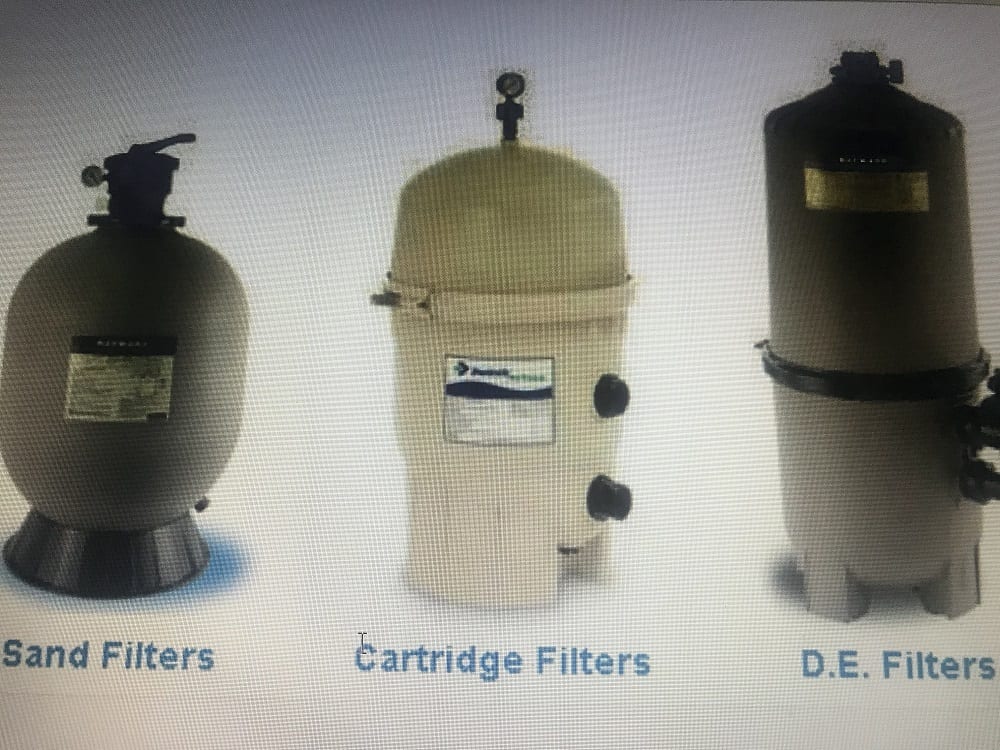
In order to keep your pool consistently clean and clear it’s imperative to have the correct size Pool equipment. If something is not the correct size, it could hinder the ability for the Pool to stay clean and clear. I often see under powered pumps for the system which results in a multitude of problems, i.e. water having a hard time staying clear because even at longer run times it has difficulty turning the water over. After prime, an underpowered pump wont give the filter enough PSI to make all the components of the system the ability to work properly, i.e. vacuum cleaner, skimmers.
A filter too small for the size Pool could result in Channeling in a sand filter; too much pressure is getting into the filter from the pump, more water is being pushed into the filter than it can handle resulting in poor filtration quality. There are steps you can take to get rid of the channeling but it will always be an issue because the pump is too large for the system.
There are many other scenarios of correctly sized equipment for each particular pool
MY POOL TURNED GREEEN AFTER ADDING CHLORINE. WHY IS THAT?
HIGH PH: Chlorine works better at a lower PH. The recommended PH levels is between 7.2-7.8 with 7.5 being ideal. Chlorine works more effectively at 7.2 than it does at 7.8 even though a PH at either of those two are considered acceptable. So when your Pool’s PH is at 8.0, 8.2 and above it’s not working as efficiently. This would rarely be the reason why your Pool would turn green but it certainly is a contributing factor.
FILTER RUN-TIME: If your Pool is not turning the water over at least once a day then it could lead to your water turning green. We really need all of the water to cycle through the filter daily to clean it in order to rid the water of contaminants. This is especially true in the summertime because of higher temperatures and higher bathing loads. Both are responsible for eating up your available chlorine which can turn into a green Pool. In the winter you can run your pump 4-6 hours a day. So make sure you have your Pool system running adequately each day.
NOT ENOUGH CHLORINE: Make sure you’re putting enough chlorine in your water to keep it clear In relation to the gallons of water in your Pool.
CYANURIC ACID LEVEL TOO HIGH: This is PROBABLY the number one reason why people have green Pools after adding chlorine. CYANURIC Acid (stabilizer, conditioner, CYA) is essentially sunblock for chlorine. Too little of CYA, and the chlorine burns off pretty quickly which can lead to a green Pool. Too much of it and chlorine will not bear able to properly sanitize your water. The recommended range is 30-50PPM. If your approaching 100 or more its time to correct thorough a partial drain and refill. Your chlorine should be 7.5% of your CYA reading. If your CYA is 110 PPM, your chlorine should be at a minimum 8 PPM. That is double the recommended chlorine levels of 1-4 PPM. If you kept your chlorine at 4 PPM you’ll get a green Pool.
How does CYA get too high? There are two types of chlorine; stabilized and un-stabilized. Un-stabilized is liquid chlorine. Stabilized is the tricolor pucks (3” tablets) or granular dichlor. The stabilized chlorine has CYA in iOS. When your shocking the Pool or putting 3” tablets in your Pool you’re adding CYA to the water. Overtime, the stabilizer is too high. With liquid chlorine you’re not adding CYA when you sanitize your water and is best for daily/weekly sanitizing.
HOW LONG DO I RUN MY POOL AFTER ADDING CHEMICALS?
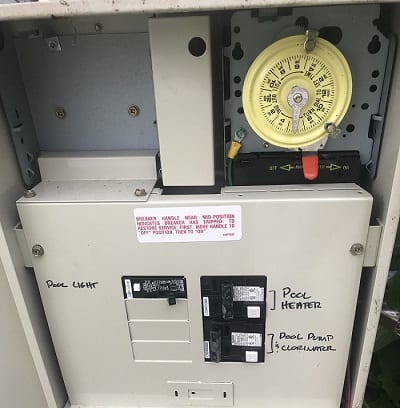
In the industry it is recognized to have the Pool run for 3 hours at a bare minimum up to 24 hours. 24 hours is overkill put it will ensure the water is completely mixed with the chemicals. If you have algae, you want to run the pump at least 8 hours a day especially if you have algae.
If you have an Intermatic Timer, then you could purchase an extra “off” tripper and place it 3-4 hours after your first “off” tripper. You can’t flip the timer to the point of just after the “off” tripper, it won’t allow it to turn on. Space the two “off” trippers far enough apart to make sure you get a solid 3 hours of run time.
If you have a digital panel like the Jandy Aqualink, the majority of them have a program called “timeout” that will run the pump for 3 hours. If not, you can manually turn the pump to allow it to cycle for 3 hours.
IF YOU NEED ANY HELP ON DOING THIS WE ARE HERE TO HELP!
I JUST GOT OUT OF THE POOL AND HAVE ITCHY SKIN
ALLERGIC REACTION: Chlorine is a salt derived from hypochlorous acid and it chemically reacts with your skin. It can cause symptoms such as burning, itching and rash development. Cleansing your skin is possibly the quickest way to get rid of this. Products are available to counter this reaction. To see if you have an allergy to chlorine visit your dermatologist to confirm this.
WATER ACIDITY: If the water is acidic it could very well cause itching in the water. Technically, a 7.0 PH is neutral o the PH scale so anything above 7.0 is technically more basic than acidic. Swim water should be above 7.2; anything below that could cause the water to be acidic and to itch. Checking your LSI will determine if your overall water chemistry is acidic. The quickest solution is to address whatever chemical is not within parameters is to balance the water.
CERCARIAL DERMATITIS: Is he medical name for “swimmers itch”. This is uncommon to cause itching but it does occur. This is an infection with parasites from affected mammals, snails, or birds. You’ll see skin irritations such as pimples or feel a continuous need to itch. The solution is to keep your water chlorinated so it kills the parasites before they affect you!.
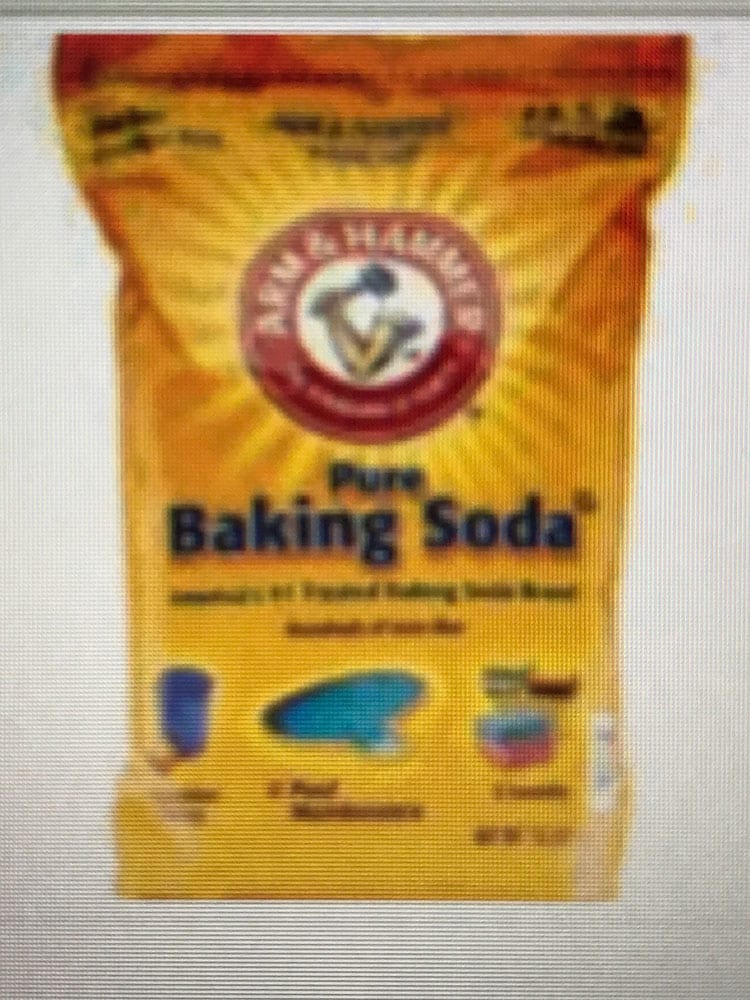
ALKALINITY-Alkalinity is one of the major components to balancing swimming pool water.
Alkalinity is a close cousin to PH. If alkalinity is low then the PH is probably low too. This may not always be the case though.
Alkalinity measures how alkaline the Pool water is. It measures things like carbonates and bicarbonates.
According to NSPF a swimming Pool should have somewhere in the range of 80-120 PPM in order to be balanced.
Alkalinity affects PH. It the alkalinity is low then you’ll get “PH Bounce” where the smallest change in the Pool water will create a rapid change in the PH. If the alkalinity is high then the Ph will be resistant to change. That means it will take more of the chemical, applied in the proper way, to make the results occur.
With low alkalinity
1. PH will become erratic.
2. Etching of the Pool or corrosion to chrome Pool equipment can occur
3. Corrosive water conditions
With high alkalinity
1. PH becomes difficult to adjust
2. You can get cloudy water or scale formation on your Pool surface and/or equipment
3. Chlorine becomes less effective due to higher PH
Either high or low can create swimming discomfort. If your alkalinity is low you can get itchy and irritated dry eyes. It’s important to keep the alkalinity in range.
ADJUSTING THE ALKALINITY
IF IT’S LOW
1. Use sodium bicarbonate (baking soda) to raise it. You can apply it directly to the skimmer to eliminate the cloud effect from broadcasting it around the Pool surface. It does not dissolve well in cold water.
2. You can expect per 10,000 gallons to see a 10 PPM change for every 1.5 lbs. applied in the Pool. If you need a 20 PPM change in a 20,000 gallon Pool you would add 5.6 lbs of bicarbonate.
3. DO NOT add 10 lbs. at once. The equipment can become sluggish. Add less if your filter is undersized.
IF IT’S HIGH
1. Use muriatic acid to lower it. Apply it in the deep end with the pump off and in 1 spot. If you broadcast it you’ll be making a bigger change in the PH.
2. Pre-dilute it first. Always add chemical to water and not the other way around. This will protect the Pools surface from it sitting on one spot in the deep end.
3. You can expect, per 10.000 gallons to see a 10 PPM change for every 24.6 ounces you add. If you need a 30 PPM change in a 10,000 gallon Pool you would add roughly 75 ounces.
If you have any questions, please don’t hesitate to CONTACT US.
PHOSPHATES: WHAT THEY ARE, WHAT THEY DO AND WHAT TO LOOK OUT FOR?
Are Phosphates causing issues in your Pool? Do you know what the signs of phosphates are? Does your swimming Pool cleaning service understand how to treat the issue? If you said “NO” to any of those questions, please read on so you can know a little git about it!
What are Phosphates?
Phosphates are food for algae and other micro organisms. When they get into your swimming Pool water, even in trace amounts, they can reek havoc on the quality of your pool water and chemistry.
How do they get into your Pool?
They are literally everywhere! Byproducts of soap, shampoo’s and even some pool chemicals are phosphates. Even some municipalities put phosphates in the water to help guard against pipe corrosion. Treating your lawn with fertilizer can cause phosphates to be in your Pool. It’s not a question of “if” they get into your Pool, it’s a question of “when”.
What are some issues you’ll see?
If you are having a hard time keeping a chlorine reading in your Pool, you very well could have phosphates. They consume the available sanitizer in the water so the more you have the less chlorine you’ll be able to keep in the water. Another sign is algae growth in a perfectly balanced Pool.
What is the recommended range?
Yes, there is an allowable amount and its 100 PPB. Notice the “B’, its parts per Billion which is a small amount. That’s one drop of water in 1 billion drops of water. As the level increases it’s only going to get worse. Phosphates are manageable until around 500 PPB Range. Beyond that you’ll see some algae growth. If your pool water has 1500-2000 PPB of phosphates you’ll notice not only the algae but the pool water has lost it’s its sheen. 3000-4000 PPB of phosphates requires several treatments before the phosphates are manageable.
How do you treat them?
If you don’t have a service company that knows how to treat phosphates either CONTACT US ( prior words caps bold teal color liked to contact page) or purchase a phosphate remover and follow the instructions on the bottle. It always helps to start with a clean filter! After the treatment is done clean the filter again, you may see increased filter pressure during the treatment. I recommend SEAKLEAR COMMERCIAL PHOSPHATE REMOVER! It’s concentrated and won’t clog the filter as quickly.
CLARIFIER OR FLOCCULANT?
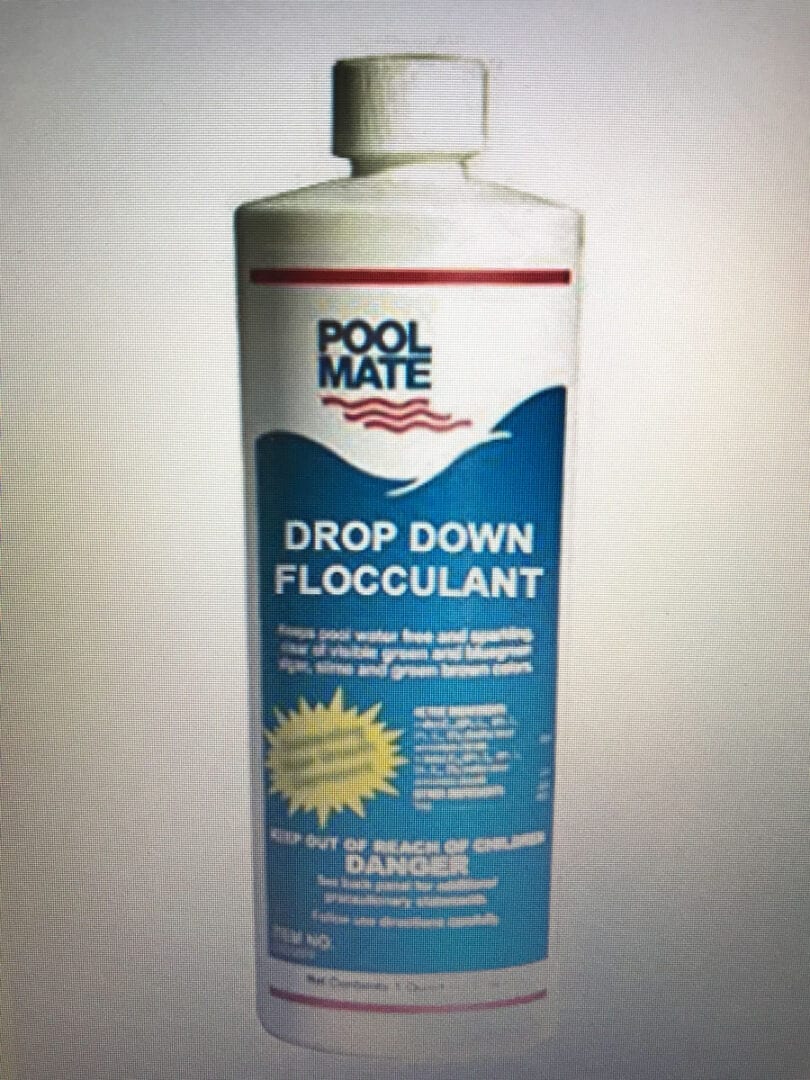
Either choice is designed to help with cloudy water (dead algae etc.) and to clear it up.
CLARIFIER is a great choice if you have to wait or don’t want to drain out part of your Pool.
It is also reasonably effortless on your part. There is not much physical work with using this.
Though coagulation, it takes small particles making them into bigger particles so the filter will catch them and pull them out of your water. The result will be a clear Pool. I would start with a clean filter and open all the valves to get full circulation. Evenly apply the dosage of your choosing top the surface and run the filter 24/7 until the filter is clear.
FLOCCULANT is great if you want fast results! It does require some physical work and you will loose dome of your water. All the particles sink to the floor. From there you vacuum the Pool to waste and remove all the debris.Yo0u should have clear water from there. If you have a cartridge filter, I would remove the cartridge before you apply the floc. If you have a sand or D.E. Filter I would move the valve to “recirculate”. This will essentially bypass the filter so the floc doesn’t go into the filter. Once this is done go ahead and apply the floc evenly across the surface and allow the system to run for 2 hours. Once this is done, turn off the system and make sure it won't turn back on; turn off the breakers. Then you want the water to sit still for 24-48 hours to allow everything to sink. Usually you can treat in the evening and the next morning get started with vacuuming. Vacuum slowly. We don’t want the cloudy material o the bottom to be disturbed. Check the weather. Postpone treatment if it’s going to rain; the rain hitting the water will disturb the process.
If you have any questions, please don’t’ hesitate to CONTACT US.
WHERE DID MY WATER GO?
The heat plays a huge role in water loss in Pools. Pools typically lose ¼’ of water per day due to evaporation. Pools on the water, lakes, beaches tend to lose a little more because of the wind which also aids in evaporation. These pool can lose as much as ¾” per day. Higher evaporation occurs when humidity is low. Splash out can also result I water loss.
How much water loss is too much? If you are constantly refilling your Poop and you believe you are loosing more than an inch per day it could very well mean your Pool is leaking.
THE BUCKET TEST: Is a test that will determine whether or not your Pool is leaking.
- Turn off the auto fill.
- Place on the first step of the Pool a five gallon bucket and mark the water line of the Pool water on the outside of the bucket. When you place the bucket on the step, the Pool water should be even with the mark you made on the bucket.
- Mark the same height of the Pool water with a line on the inside of the bucket . Internal and external lines should be at the same height.
- Fill up the bucket to the internal line with Pool water only. The pool water inside of the bucket should be at the same height as the rest of the Pool after your place the bucket on the step.
- Watch the levels in the bucket for the next 48-72 hours. If they are lower at the same rate its just evaporation. If the Pool water level lowers at a faster rate, then you more than likely have a leak.
WHERE IS THE LEAK?
- Visually inspect the equipment for leaks. If it hasn’t rained and you have standing water at the base of your pump or filter it may be this is where your leak is coming from. Check to see that the drain plugs are tight on your pump and filters.
- Check the fittings on your plumbing. If the seal is worn away it could induced a leak. If you visually notice water between two pipes, this is where the leak could be coming from.
- Is the water leaking when the pump is on? This tends to be a pressure side leak. Check for water leaks from the top of the pump through the filter and all the way back to the returns.
- Is the water leaking when the Pool equipment is off? If so, this tends to be a suction side leak. Check for water leaks from the intake lines all the way to the side of the pump. If you are continually running the equipment with water lower than the skimmer you could compromise the seals of the adjoined pipes connected to the pump. Make sure the o ring of the pump lid is good and lubed with a lubricant like Magic Lube.
- Does your water stop at a certain level? If it stops just below the skimmer that Mens you probably have a leak somewhere in the skimmer line. The Pool light has a hole in the niche where the cord goes through a gasket around it to help create a water tight seal which over time can fail. The niche is at the top so that would explain why the water level stops just below the top of the light.
- Is the water leaking all the time regardless if the equipment is on or off and doesn’t stop at a certain level? This tends to do with the vessel (body) of your Pool. You may have a crack in the bottom that is hard to see or along the walls or steps.
- Walk around the perimeter of your pool deck on a day it hasn’t rained, there are no swimmers and see if there are any wet spots on the deck. That area may be the source of your problem.
If you aren’t having any luck at this point GIVE US A CALL to schedule a leak detection of your Pool. We are Certified in Leak Detection. Visit our LEAK DETECTION page in Our services part of this site.
WHY IS MY POOL CLOUDY?
While there are several reasons for why cloudy Pools happen, here are a few things to look out for!
1. THE ENVIRONMENT- Any foreign material or substances that is not meant to be in your Pool (not water, chlorine, etc.) can cause cloudy water. Animals, weather, lawn clippings, excessive bathing loads, even sunblock and skin lotion can be a cause of cloudy water. Proactive measures to keep the Pool looking clear is to shower before entering the Pool, don’t allow leaves to sit at the bottom of the Pool and keeping the water balanced.
2. FILTRATION-Keeping the pool filter running for the correct amount of time is vital. It filters and cleans out the water to keep it clear. If the water is left standing it can get cloudy. In the summertime run your filter 8-10 hours a day. During the fall it is good to run your filter 6-8 hours a day. Routinely clean your filter so it can efficiently do its job in keeping your water cleaned.
3. For a CARTRIDGE FILTER - you want to clean the filter when the operational pressure is 10 PSI or more. Replace the filter once per year. Most filter elements last for 2500 hours of filtering before the capability is greatly diminished.
4. For a DE FILTER, you want to backwash it every couple of months to as often as once a month( don’t forget to recharge the filter with more DE powder according to the square feet of the filter) or when the operating pressure rises more than 10 PSI above starting. Once a year you will take out the grids and Coleman them because they will be clogged with powder, dirt, debris, etc. This will hinder the filters ability to clean the water.
5. For a SAND FILTER, you want to backwash depending on bathing loads, environment, algae Blooms, etc. Backwashing is also something that is needed once the pressure rises above 10 PSI above the starting pressure. You should replace the sand every 5-7 years.
6. PROPER WATER CHEMISTRY should be checked at least once a week in order to keep the water balanced which will aid in water clarity. If the chemicals are excessively high in your water, then it could create a cloudy aquatic environment. Things such a high chlorine (except for shocking the water), high PH, high alkalinity and high calcium hardness can all attribute to cloudy water. All of them except calcium hardness can be addressed with a chemical to reduce the offending chemical.
7. Calcium hardness can only be reduced by diluting through water replacement.
Brushing the walls, steps and floor of your pool may cause cloudy water which your filter will take of that if the filter is working properly.
SHOCK
When you walk into a pool store there are endless supplies of “shock” from companies promising that it you use their product, then the pool will conquer the battle with algae. Shock is nothing more than a glamorized form of chlorine. There are only two types of chlorine, stabilized and un-stabilized.
Shock is a procedure not a product since shock is not a tangible product. It’s an intangible procedure that involves keeping your chlorine at high levels for extended periods of time.
Shock is not a one time deal with a product the pool store is trying to push you to buy. If you need help in shocking your Pool, click the button below and let us help you with that!
STRONG CHLORINE SMELL IN YOUR POOL?
The high chlorine smell is caused by Chloramines which are a lot less powerful in sanitation than chlorine is. Chloramines are formed when the chlorine combines with organic matter such as sweat, urine, fecal matter, oils, makeup, sunblock and any foreign matter left behind once you left the pool. Once you have a combined chlorine reading of 0.6 PPM or more its time to super chlorinate, or shock your pool water because your chlorine can’t do what its supposed to do.
That chlorine smell isn’t chlorine but contaminated water.
If you a have pool that reeks of chlorine or burning eyes after opening them under water you need to get your water balanced.
CONTRACT US to balance your water!
Things Your Pool Service Technician Wants You to Know
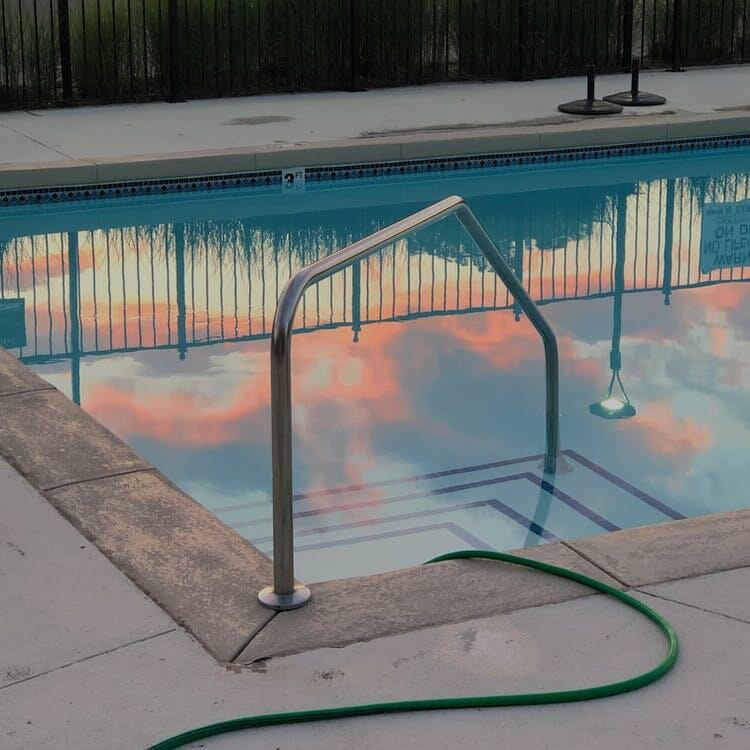
Sometimes, when homeowners hire a technician to solve a problem in their home, they forget that the problem is still primarily their responsibility. The technician is there to work with the homeowners but the technician doesn’t assume the owner’s responsibility for looking after the property.
This is true for every technician you hire, including your pool guy. Through training and experience, your pool service technician knows more about swimming pools than you do but the swimming pool is your property. As the owner of the pool, the responsibility for it also belongs to you.
Moreover, your pool guy is usually there only a few days in the week and sometimes even less than that. This means your actions have a far greater impact on the pool than anything your technician does. This is why you should know everything you need to keep your pool in top shape, says Income Realty.
It is also why pool technicians want you to have the vital information that will help make their work easier and the relationship better. If you were to have a chat with your pool technician, what are the things they would like you to know about maintaining your swimming pool?
1. A regularly maintained pools cost less in the long run
The real cost of owning a swimming pool is the long-term effort of maintaining it. The little actions you take every day add up to determine the future value of your pool. Many of these daily steps for managing a pool require only a few minutes of committed action.
2. You should deal with issues early and when they are small
Your pool technician is not trying to get you to spend more money. They are actually being professional and helping you save money when they tell you to take care of apparent minor issues before they become worse.
3. Your pool still needs service even if you don’t use it
Doing maintenance on a swimming pool during off-season might seem to you like a waste of money. But actions taken during the months when a pool is not in use will help ensure the pool is ready for use at the start of pool season.
4. 24-48 hours is a long time in the life of a pool
A swimming pool can turn green in less than 48 hours. Imagine what could happen if it is left unattended for 2-3 weeks. Because water is a universal solvent and natural habitat, your pool could easily turn into a toxic cocktail of algae and bacteria.
5. It’s alright if you don’t want to commit to regular servicing
If you feel like you don’t need to have a maintenance contract for fortnightly or monthly servicing, that is fine. There is no need to feel as if you are being pressured to sign-up for that. Even if the technician thinks it’s the best thing for your pool, they can still work out something with you.
6. A technician can’t tell if your water is balanced just by looking at it
If the technician insists on testing the water to know if it is balanced or not, they are not wasting your time or money. As a matter of fact, you should be pleased when a technician does this; it shows they are professional.
7. If you have a pool party, tell your technician weeks ahead
Don’t leave it to the last minute before you inform your technician that you are going to have a pool party. There will probably be several small problems that have to be solved to get the pool to the best shape. One week may not be enough time.
8. Your fences need updating periodically
The pool fence may not be part of your pool guy’s job description but it is still part of the swimming pool system. What you may not know is your pool fence might no longer comply with local regulations. You should get someone to look at it.
9. Some problems cannot be patched
Do you have holes in your pool or are the tiles falling off? If the pool guy says gluing the tiles back on or patching with duct tape, epoxy, or silicone will not work, they already considered those solutions. If you really want to save money, solve the problem from its root.
10. Ask the technician before you try to help out
You can unintentionally make a problem worse or make the pool technician’s work more difficult (and your labor costs higher) if you try to help out without asking the technician first. For instance, you should not help the technician drain a vinyl pool unless the pool guy gives the go-ahead.
11. Please keep pets and small children out of the way
A swimming pool is a naturally dangerous environment for little children and pets. That danger is multiplied when there are heavy tools and electrical cords all over the place. Even if a technician won’t tell you, they really don’t want kids or pets around when they are working.
Natural-Pool Owners Are Kissing Chlorine and Other Chemicals Goodbye
An ‘Airbnb for Pools’ Is Making a Splash This Summer

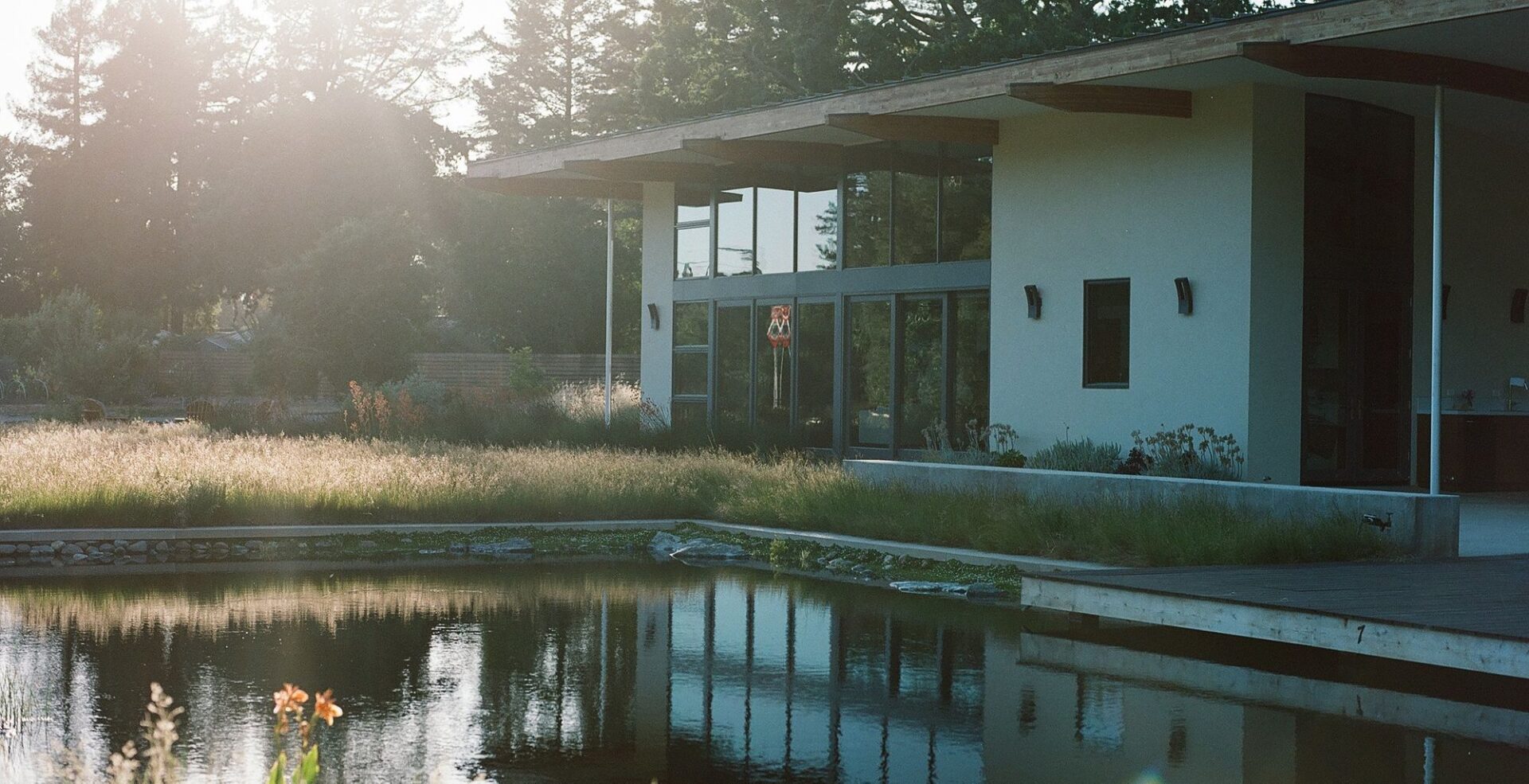
Swimply reports surge in demand amid pandemic, rising pool-chemical costs.
Jim Battan’s tree-lined swimming pool at his home outside Portland, Ore., had been sitting untouched since his youngest daughter moved out two years ago. Then in September, he listed it through an online platform for renting private pools.
He booked the pool three times within the first two hours, and says he has hosted 2,700 guests in less than a year. Mr. Battan expects to have earned $111,000 by the end of the summer, which would just cover the $110,000 he and his wife spent on the custom-built pool eight years ago.
“I thought, ‘Wow, that’s weird,’ ” Mr. Battan said. “It’s nice to feel like we didn’t have to spend all $110,000 for nothing.”
He is one of 13,000 pool owners in 125 markets across the U.S., including cities like Los Angeles and Austin, Texas, who are cashing in on their underused pool by listing with the company Swimply, which some media reports have dubbed the “Airbnb for backyard pools.”
Swimply said its pool owners have made about 122,000 bookings since the start of 2020. Business began picking up before the Covid-19 pandemic, but it boomed during the health crisis as public pools closed and people sought to make extra cash or safely gather after months of lockdown.

